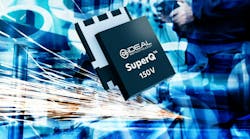Mini MOSFET with Ultra-Low On-Resistance Targets Fast-Charging Apps
ROHM Semiconductor’s AW2K21 consists of a pair of 30-V N-channel power MOSFETs, configured in a common-source configuration that delivers an on-resistance of just 2.0 mΩ (typ.) in a compact 2.0- × 2.0-mm package. Able to deliver up to 20 A at between 28 and 30 V, its low losses and compact form factor address the requirements of products such as smartphones and other smaller devices with large-capacity batteries that need fast charging times and bidirectional protection.
The device is a space-saving alternative to conventional solutions that typically use two discrete, large, low on-resistance MOSFETs. The AW2K21’s two MOSFETs are integrated in a single package using a proprietary structure that enhances cell density while minimizing the on-resistance per unit chip area.
Unlike standard vertical trench MOS structures, the proprietary structure places the drain terminal on the top surface, which enables the use of a WLCSP package. In power supply and charging circuits for compact devices, the integrated dual MOSFET can reduce the solution footprint and on-resistance per unit area up to 81% and 33%, respectively. ROHM also claims that, even compared to similarly sized GaN HEMTs, on-resistance is decreased by up to 50%.
On top of that, the AW2K21 is suitable for use as a unidirectional protection MOSFET in load switch applications. At the same time, ROHM is further pushing the limits of miniaturization with the development of an even smaller 1.2- × 1.2-mm model. Datasheets and application information are available here.
Next in This Edition of PowerBites
More PowerBites
About the Author
Lee Goldberg
Contributing Editor
Lee Goldberg is a self-identified “Recovering Engineer,” Maker/Hacker, Green-Tech Maven, Aviator, Gadfly, and Geek Dad. He spent the first 18 years of his career helping design microprocessors, embedded systems, renewable energy applications, and the occasional interplanetary spacecraft. After trading his ‘scope and soldering iron for a keyboard and a second career as a tech journalist, he’s spent the next two decades at several print and online engineering publications.
Lee’s current focus is power electronics, especially the technologies involved with energy efficiency, energy management, and renewable energy. This dovetails with his coverage of sustainable technologies and various environmental and social issues within the engineering community that he began in 1996. Lee also covers 3D printers, open-source hardware, and other Maker/Hacker technologies.
Lee holds a BSEE in Electrical Engineering from Thomas Edison College, and participated in a colloquium on technology, society, and the environment at Goddard College’s Institute for Social Ecology. His book, “Green Electronics/Green Bottom Line - A Commonsense Guide To Environmentally Responsible Engineering and Management,” was published by Newnes Press.
Lee, his wife Catherine, and his daughter Anwyn currently reside in the outskirts of Princeton N.J., where they masquerade as a typical suburban family.
Lee also writes the regular PowerBites series.






